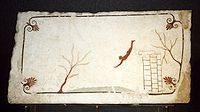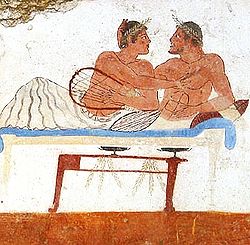
Tomb of the Diver
Encyclopedia
The Tomb of the Diver is an important archaeological monument, found by the Italian archaeologist Mario Napoli on 3 June 1968 during his excavation of a small necropolis
about 1.5 km south of the Greek
city of Paestum
in Magna Graecia
, now southern Italy
. The tomb is now displayed in the museum at Paestum.
It is a grave
made of five local limestone
slabs forming the four lateral walls and the roof, the floor being excavated in the natural rock ground. The five slabs, accurately bonded with plaster
, formed a chamber sized — roughly – 215 × 100 × 80 cm (7.1 × 3.3 × 2.6 ft). All five slabs forming the monument were painted on the interior sides using a true fresco
technique. The paintings on the four walls depict a symposium
scene, while the cover slab shows the famous scene that gives the tomb its name: a young man diving into a curling and waving stream of water. Two masters have been distinguished, the south wall being by a less impressive artist than the others.
When the tomb was discovered, these surprising frescos revealed its importance as they appear to be the "only example of Greek painting with figured scenes dating from the Orientalizing, Archaic
, or Classical
periods to survive in its entirety. Among the thousands of Greek tombs known from this time (roughly 700–400 BC), this is the only one to have been decorated with frescoes of human subjects."
In the interior of the tomb, only a few objects were found: near the corpse (widely supposed to be a young man, despite the heavily deteriorated state of the skeleton) were a turtle shell, two arýballoi
and an Attic
lekythos
. These must have been the deceased youth's oil flasks, the ones he used to oil himself for wrestling practice at the gym
nasium, and his favorite drinking cup. This last object, in black-figure
technique from about 480 BC, helped the discoverer and other scholars to date the tomb to about 470 BC
.
Necropolis
A necropolis is a large cemetery or burial ground, usually including structural tombs. The word comes from the Greek νεκρόπολις - nekropolis, literally meaning "city of the dead"...
about 1.5 km south of the Greek
Ancient Greece
Ancient Greece is a civilization belonging to a period of Greek history that lasted from the Archaic period of the 8th to 6th centuries BC to the end of antiquity. Immediately following this period was the beginning of the Early Middle Ages and the Byzantine era. Included in Ancient Greece is the...
city of Paestum
Paestum
Paestum is the classical Roman name of a major Graeco-Roman city in the Campania region of Italy. It is located in the north of Cilento, near the coast about 85 km SE of Naples in the province of Salerno, and belongs to the commune of Capaccio, officially also named...
in Magna Graecia
Magna Graecia
Magna Græcia is the name of the coastal areas of Southern Italy on the Tarentine Gulf that were extensively colonized by Greek settlers; particularly the Achaean colonies of Tarentum, Crotone, and Sybaris, but also, more loosely, the cities of Cumae and Neapolis to the north...
, now southern Italy
Italy
Italy , officially the Italian Republic languages]] under the European Charter for Regional or Minority Languages. In each of these, Italy's official name is as follows:;;;;;;;;), is a unitary parliamentary republic in South-Central Europe. To the north it borders France, Switzerland, Austria and...
. The tomb is now displayed in the museum at Paestum.
It is a grave
Grave (burial)
A grave is a location where a dead body is buried. Graves are usually located in special areas set aside for the purpose of burial, such as graveyards or cemeteries....
made of five local limestone
Limestone
Limestone is a sedimentary rock composed largely of the minerals calcite and aragonite, which are different crystal forms of calcium carbonate . Many limestones are composed from skeletal fragments of marine organisms such as coral or foraminifera....
slabs forming the four lateral walls and the roof, the floor being excavated in the natural rock ground. The five slabs, accurately bonded with plaster
Plaster
Plaster is a building material used for coating walls and ceilings. Plaster starts as a dry powder similar to mortar or cement and like those materials it is mixed with water to form a paste which liberates heat and then hardens. Unlike mortar and cement, plaster remains quite soft after setting,...
, formed a chamber sized — roughly – 215 × 100 × 80 cm (7.1 × 3.3 × 2.6 ft). All five slabs forming the monument were painted on the interior sides using a true fresco
Fresco
Fresco is any of several related mural painting types, executed on plaster on walls or ceilings. The word fresco comes from the Greek word affresca which derives from the Latin word for "fresh". Frescoes first developed in the ancient world and continued to be popular through the Renaissance...
technique. The paintings on the four walls depict a symposium
Symposium
In ancient Greece, the symposium was a drinking party. Literary works that describe or take place at a symposium include two Socratic dialogues, Plato's Symposium and Xenophon's Symposium, as well as a number of Greek poems such as the elegies of Theognis of Megara...
scene, while the cover slab shows the famous scene that gives the tomb its name: a young man diving into a curling and waving stream of water. Two masters have been distinguished, the south wall being by a less impressive artist than the others.
When the tomb was discovered, these surprising frescos revealed its importance as they appear to be the "only example of Greek painting with figured scenes dating from the Orientalizing, Archaic
Archaic period in Greece
The Archaic period in Greece was a period of ancient Greek history that followed the Greek Dark Ages. This period saw the rise of the polis and the founding of colonies, as well as the first inklings of classical philosophy, theatre in the form of tragedies performed during Dionysia, and written...
, or Classical
Classical Greece
Classical Greece was a 200 year period in Greek culture lasting from the 5th through 4th centuries BC. This classical period had a powerful influence on the Roman Empire and greatly influenced the foundation of Western civilizations. Much of modern Western politics, artistic thought, such as...
periods to survive in its entirety. Among the thousands of Greek tombs known from this time (roughly 700–400 BC), this is the only one to have been decorated with frescoes of human subjects."
In the interior of the tomb, only a few objects were found: near the corpse (widely supposed to be a young man, despite the heavily deteriorated state of the skeleton) were a turtle shell, two arýballoi
Aryballos
An aryballos was a small spherical or globular flask with a narrow neck used in Ancient Greece. It was used to contain perfume or oil, and is often depicted in vase paintings as being used by athletes bathing...
and an Attic
Attica
Attica is a historical region of Greece, containing Athens, the current capital of Greece. The historical region is centered on the Attic peninsula, which projects into the Aegean Sea...
lekythos
Lekythos
A lekythos is a type of Greek pottery used for storing oil , especially olive oil. It has a narrow body and one handle attached to the neck of the vessel. The lekythos was used for anointing dead bodies of unmarried men and many lekythoi are found in tombs. The images on lekythoi were often...
. These must have been the deceased youth's oil flasks, the ones he used to oil himself for wrestling practice at the gym
Gym
The word γυμνάσιον was used in Ancient Greece, that mean a locality for both physical and intellectual education of young men...
nasium, and his favorite drinking cup. This last object, in black-figure
Black-figure pottery
Black-figure pottery painting, also known as the black-figure style or black-figure ceramic is one of the most modern styles for adorning antique Greek vases. It was especially common between the 7th and 5th centuries BC, although there are specimens dating as late as the 2nd century BC...
technique from about 480 BC, helped the discoverer and other scholars to date the tomb to about 470 BC
470 BC
Year 470 BC was a year of the pre-Julian Roman calendar. At the time, it was known as the Year of the Consulship of Potitus and Mamercus...
.
Gallery
 The whole cover slab (inside) |
 Symposium Symposium In ancient Greece, the symposium was a drinking party. Literary works that describe or take place at a symposium include two Socratic dialogues, Plato's Symposium and Xenophon's Symposium, as well as a number of Greek poems such as the elegies of Theognis of Megara... , north wall |
 detail, north wall |
 Symposium Symposium In ancient Greece, the symposium was a drinking party. Literary works that describe or take place at a symposium include two Socratic dialogues, Plato's Symposium and Xenophon's Symposium, as well as a number of Greek poems such as the elegies of Theognis of Megara... , south wall, by a different artist from the others |

